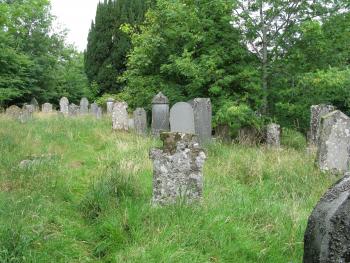- Navigation:
- Back to the Corpus index page
- RSS
Killin Parish Church
Killin Churchyard 1
- Dedication: uncertain/St Fillan
- Diocese of Dunkeld
- Deanery of Athole and Drumalbane
- County of Perthshire
- Stirling Council
- NN 5739 3333
Summary description
The medieval parish church is assumed to have been in the graveyard a short distance to the north-east of the present church, though nothing of it remains visible.
Historical outline
Dedication: uncertain/St Fillan
First recorded as a free parsonage in Bagimond’s Roll in 1274, in February 1318 King Robert I granted the church of Killin to the canons of Inchaffray Abbey on the condition that one of the canons would celebrate in the church of Strathfillan.(1) Eight months later, William, bishop of Dunkeld, confirmed the king’s grant with its requirement for the abbey to serve the chapel of St Fillan in Glendochart with one of their own canons, and confirmed also the appropriation of the church of Killin to Inchaffray.(2) It appears to have been Bishop William’s intention that Inchaffray would establish a priory cell at St Fillan’s. The grant in proprios usus also involved a vicarage settlement whereby the canons were obliged to provide a secular chaplain to serve the cure at Killin, with reservation of £10 annually from the fruits of the parish for his portion, or the right to serve the church with one of their own brethren. From this date, it appears that the intention was for Killin and Strathfillan to be conjoined, with parsonage and most of the vicarage fruits annexed to the priory cell of Strathfillan and its mother-house at Inchaffray. There are, however, some difficulties with this seemingly straightforward arrangement.
In November 1348, despite the bishop’s grant in proprios usus and its confirmation at the same date by the dean and chapter of Dunkeld, it was only the patronage of the church of Killin which was confirmed in Inchaffray’s possession by Pope Clement VI.(3) In 1413, it was claimed in a papal letter that the rector of Ardeonaig had demitted his charge to receive collation to the church of Killin, an exchange which seems rather unequal if the latter were only a vicarage portionary.(4) In May 1557, however, it appears that the cure was being served only by a chaplain curate, which would point to the annexation to Inchaffray as having been effective.(5) At the Reformation, it is recorded explicitly that the church was served by a vicar pensionar.(6)
Notes
1. SHS Misc, vi, 47, 73; Inchaffray Charters, no CXXIII.
2. Inchaffray Charters, no CXXVI.
3. Inchaffray Charters, nos CXXVII, CXXXI.
6. Kirk (ed.), Book of Assumptions, 321; Donaldson (ed.), Thirds of Benefices, 14.
Architectural description
The church currently in use for worship was built in 1744 by Thomas Clark, probably to the designs of John Douglas. Initially of octagonal plan, it was enlarged to a more complex – and less coherent - plan in 1831-2. The predecessor of that church was in the graveyard to the north-east of the present church, where there are numbers of eighteenth- and nineteenth-century gravestones, and at the entrance to the graveyard is the shell of what appears to be an early nineteenth-century watch house. Nothing remains visible of the earlier church itself, though it seems that its ruins were still to be seen at the time that the Statistical Account was published in 1796. A seven-sided basin that is in use in the present church as a baptismal font is said to have been from the medieval church, though, like so many so-called ‘medieval fonts’ brought back into use, it is perhaps more likely to have been a domestic mortar. The bell of 1632 in the present church, however, presumably did come from its predecessor.
Bibliography
Bowie, W., 1855, The black book of Taymouth, ed. C. Innes, Edinburgh, 28, 33, 118, 123, 140.
Charters, Bulls and other Documents relating to the Abbey of Inchaffray, 1908, (Scottish History Society), Edinburgh, nos CXXIII, CXXVI, CXXVII, CXXXI.
Donaldson, G. 1949, Accounts of the collectors of thirds of benefices, (Scottish History Society), Edinburgh, 14.
Dunlop, A.I., 1939, ‘Bagimond’s Roll, statement of the tenths of the kingdom of Scotland’, Miscellany of the Scottish History Society, vi, 1-77, at 47, 73.
Gifford, J. and Walker, F.A., 2002, The Buildings of Scotland, Stirling and Central Scotland, New Haven and London, 551.
Gillies, W.A., 1938, In famed Breadalbane, Perth, 282-95.
Kirk, J., 1995, The books of assumption of the thirds of benefices, (British Academy) Oxford, 321.
New Statistical Account of Scotland, 1845, Edinburgh and London, x, 1092.
Reports on the state of certain parishes in Scotland, 1835, ed. A. Macdonald, (Maitland Club), Edinburgh, 180.
Statistical Account of Scotland, 1791-9, ed. J. Sinclair, Edinburgh, xvii (1796), 377-9.
Map
Images
Click on any thumbnail to open the image gallery and slideshow.









